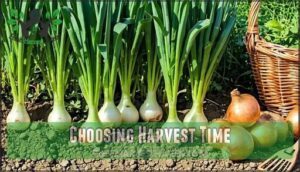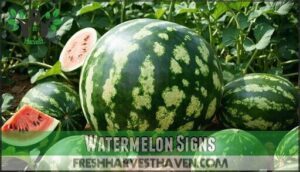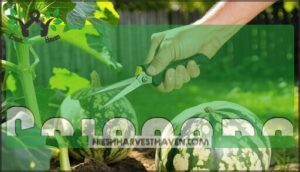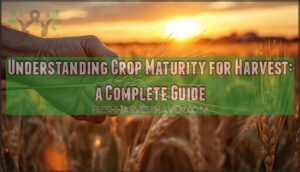This site is supported by our readers. We may earn a commission, at no cost to you, if you purchase through links.
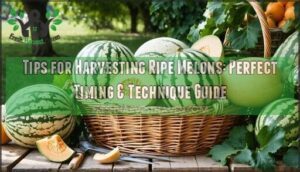
Check your melon’s "slip" – the stem should crack and release easily when gently twisted.
For cantaloupes, look for beige netting and a sweet aroma at the blossom end.
Watermelons develop a creamy ground spot and sound hollow when tapped.
Honeydews turn creamy yellow with slight give at the blossom end.
Cut stems with clean garden shears rather than pulling, which can damage the fruit.
Harvest during cool morning hours when sugar content peaks.
Different varieties have unique ripeness signals that seasoned growers learn to read like nature’s own ripeness calendar.
Table Of Contents
Key Takeaways
- Watch for variety-specific ripeness signals – You’ll know cantaloupes are ready when they slip easily from the vine with a gentle twist, while watermelons develop a creamy yellow ground spot and sound hollow when tapped.
- Harvest during cool morning hours – You’ll capture peak sugar content and sweetness by picking melons in the morning when temperatures are between 70-80°F and sugar levels are at their highest.
- Use proper cutting techniques – You should cut stems with clean garden shears at a slight angle, leaving 1-2 inches attached, rather than pulling or forcing separation, which can damage the fruit.
- Handle melons gently after harvest – You need to support melons from underneath during transport, cool them immediately in shade, and store at proper temperatures (50-60°F for most varieties) to preserve quality and extend shelf life.
Choosing Harvest Time
You’ll know it’s time to harvest your melons when they show clear signs of ripeness specific to their variety.
The key is learning to read these natural indicators rather than guessing based on size or days since planting.
Variety of Melon
Different melon types require unique harvesting approaches due to their distinct climacteric behavior and maturity differences.
Understanding variety differences helps you pick at peak ripeness.
- Cantaloupe – Climacteric fruit that develops an abscission layer, allowing easy stem separation
- Honeydew – Non-climacteric variety requiring careful monitoring since it won’t ripen further off-vine
- Watermelon – Shows surface changes and field spot development when ready
- Regional varieties – Galia, Casaba, and Crenshaw have specific ripeness indicators
- Heirloom melons – Traditional cultivars may exhibit weakly climacteric traits requiring extra attention
To guarantee proper storage, remember that watermelon is distinct from muskmelons.
Color and Appearance
A melon’s skin color transformation signals peak ripeness, revealing nature’s harvest calendar through visual cues.
Watch for specific color changes that indicate prime sugar development and flavor concentration in your garden’s bounty.
| Melon Type | Rind Color Change | Surface Features | Key Visual Signs |
|---|---|---|---|
| Cantaloupe | Green to creamy yellow/golden | Raised netting pattern becomes pronounced | Dull surface sheen replaces glossy appearance |
| Watermelon | Dark green to matte finish | Field spot turns creamy yellow | Surface loses glossy sheen, becomes dull |
| Honeydew | Pale green to waxy cream/yellow | Smooth, waxy texture develops | Skin transitions from matte green to lustrous cream |
| All Varieties | Background color lightens substantially | Tendril color shifts from green to brown/black | Overall appearance becomes less vibrant, more muted |
The visual cues provided by the melon’s skin color transformation are crucial for determining the optimal harvest time, as they indicate the melon has reached its full flavor potential.
The Stem Test
Beyond visual cues, the stem test provides definitive ripeness confirmation through vine detachment behavior.
Different melon types show distinct stem responses when ready for harvest.
- Cantaloupe: Full slip occurs when the abscission layer forms, allowing clean separation with gentle pressure
- Honeydew: Stem resistance remains high even when ripe – never relies on slip method
- Watermelon: Nearest tendril dries and browns, indicating the stem snap method timing
- General rule: Forced twisting means premature harvest – wait for natural melon stem condition changes
To guarantee the best flavor, consider sweet fruit perfume as an additional indicator.
Harvesting Techniques
Once you’ve identified a ripe melon, you’ll need proper technique to harvest it without damage.
The method you choose depends on your melon variety—some detach naturally while others require clean cuts with sharp tools.
Cutting Methods
When harvesting melons with cutting methods, use clean garden shears or a sharp harvest knife to prevent contamination and guarantee tool sanitation.
Cut at a slight angle, leaving a one-to-two-inch stem length attached to the fruit. Apply gentle handle pressure during cutting to avoid bruising, maintaining steady control for clean detachment.
Choosing the right tool can affect the quality of the cut.
These harvesting techniques protect the melon’s integrity while reducing pathogen entry points, ensuring a clean and safe harvest with proper harvesting techniques.
Stem Snap Method
For cantaloupes specifically, watch for the slip stage when the abscission layer forms naturally.
Apply gentle pressure with a slight twist near the stem end—a ripe melon will detach with surprising ease.
If you feel vine resistance during this gentle twist, step back; forcing detachment means it’s not ready.
This melon harvesting technique works because cantaloupe stems naturally separate when sugars peak, making detachment ease your best indicator for perfect timing.
Understanding the cantaloupe stem slip process is vital for determining the ideal harvest time.
Handling Precautions
Proper gentle handling prevents costly bruises that destroy melon quality. After snapping stems, cradle each fruit like precious cargo during transport.
- Gentle Handling: Support melons from underneath, avoiding pressure on sides that creates internal damage
- Fruit Inspection: Check for soft spots or cracks before moving to storage areas
- Damage Prevention: Use padded containers and avoid dropping or stacking melons during postharvest handling
Using proper melon handling tools is essential for minimizing damage. Quick cooling and proper storage maintain peak flavor.
Melon Ripeness Indicators
Knowing when your melons are perfectly ripe takes some observation, but the signs are clear once you know what to look for.
Each melon variety displays distinct indicators that signal peak ripeness and ideal harvest timing.
Cantaloupe Signs
Identifying cantaloupe ripeness requires examining several key visual and tactile indicators.
Look for netting patterns that appear raised and well-defined across the surface.
The color change from green to creamy golden hues beneath the webbing signals maturity.
At the slip stage, cantaloupes detach easily from vines with gentle pressure.
A fragrance test reveals sweet, musky aromas near the stem end.
The rind texture should yield slightly when pressed at both ends, indicating prime ripeness.
To guarantee the best flavor, check for cantaloupe ripeness before harvesting.
Honeydew Signs
Unlike cantaloupes, honeydew melons won’t slip from the vine when ready. Instead, you’ll need to look for these specific honeydew ripeness indicators that signal perfect timing for your melon harvest signs.
- Honeydew Color: The skin transforms from pale green to creamy yellow or golden, with no green patches remaining on a ripe melon
- Skin Texture: A waxy coating develops, making the surface feel smooth and slightly sticky to the touch
- Ripeness Test: The blossom end yields slightly when pressed gently, indicating proper fruit softening inside
- Weight Check: Heavy-for-size melons indicate high water content and ideal melon ripeness test results
To achieve the best flavor and texture, it’s vital to understand fruit ripeness signs when harvesting honeydew melons.
Watermelon Signs
Knowing when to harvest melon hinges on clear watermelon ripeness indicators.
Check the Field Spot: a creamy yellow patch signals a ripe watermelon, while a white or green spot means wait.
The Rind Color should look dull, not shiny.
Tendril Dry is key—the nearest tendril should be brown and dry.
Fruit Weight matters too; heavier melons usually mean juicier, sweeter bites.
Avoiding Common Mistakes
Even experienced gardeners make critical harvesting errors that can ruin months of careful cultivation.
You’ll avoid disappointment by recognizing these three major pitfalls: picking melons before they’re fully ripe, treating all varieties the same way, and handling the fruit too roughly during harvest.
Picking Too Early
Harvesting melons too soon robs them of peak sweetness and proper texture.
When to harvest melon depends on clear ripeness indicators rather than calendar dates.
Early picking results in bland, hard fruit that won’t improve after harvest.
Melons don’t continue ripening once removed from the vine, making harvest timing critical for fruit quality.
Watch for specific ripeness signs and trust these natural signals over estimated maturity dates to avoid melon damage from premature harvesting.
Ignoring Variety Differences
Confusion often arises when you treat all melon types the same. Each melon variety has unique ripeness indicators and fruit texture.
To master Harvest Timing and General Care, remember:
- Cantaloupes slip from the vine when ripe.
- Honeydews need a creamy yellow skin.
- Watermelons show a dull rind and yellow field spot.
- Ripeness signs differ.
- Adjust harvesting techniques accordingly.
Rough Handling
Many gardeners treat melons like basketballs, but these delicate fruits bruise easily and develop cracks from rough handling.
Use gentle lifting techniques with both hands supporting the fruit’s weight. Consider handling tools like padded containers for fruit cushioning, and always leave a short stem stub when cutting to prevent disease entry points.
Proper damage control through careful bruise prevention maintains quality and extends shelf life substantially. Effective harvesting techniques to avoid bruising, such as using gentle handling methods, are vital for minimizing damage and preserving the fruit’s quality.
Optimal Harvest Timing
You’ll want to time your harvest carefully since melons reach peak sweetness within a narrow 2-4 day window after full ripeness.
Weather plays a vital role—hot, dry conditions speed up ripening and shorten your harvest window, while rain near harvest time can dilute the sugars and reduce that coveted sweetness you’ve been waiting for.
Weather Conditions
Weather conditions dramatically affect melon ripening and harvesting success.
Temperature effects accelerate ripening during hot summer months, while drought stress can concentrate sugars but reduce size. Rain impact before harvest dilutes sweetness and increases spoilage risk.
Consider these ideal harvest conditions:
- Clear, dry weather for 2-3 days before picking
- Morning temperatures between 70-80°F for best handling
- Low humidity levels to prevent surface moisture buildup
- Adequate sunshine hours throughout the growing season for sugar development
Heat waves can cause rapid overripening, shortening your harvest window substantially.
Sugar Content
Ideal sugar levels determine when you’ll enjoy peak melon sweetness.
Sugar content doesn’t increase after harvest, making timing critical for maximum fruit sweetness.
The ripening process concentrates natural sugars, with quality melons reaching 10-14% sugar content at maturity.
| Melon Type | Sugar Content | Quality Standard |
|---|---|---|
| Watermelon | 6-10% | 8% minimum for grade 1 |
| Cantaloupe | 8-12% | 10% for good eating quality |
| Honeydew | 8-10% | 12-14% ideal for local markets |
| Specialty | 6-14% | Varies by variety |
| Commercial | 8-10% | USDA grade requirements |
Shelf Life
Your melons’ shelf life depends on freshness factors like harvest timing and storage conditions.
For best shelf stability, cool them quickly, store whole fruits at 50–60°F, and avoid washing before storage.
Handle gently to prevent bruising and melon spoilage.
Cut fruit should go in airtight containers.
Smart fruit storage and ripening control keep your postharvest bounty tasting its best.
Post-Harvest Handling
Once you’ve picked your perfect melon, you’ll want to handle it like the treasure it’s to preserve that peak flavor and texture.
Proper post-harvest care makes the difference between a melon that stays sweet for weeks and one that turns mushy in days, which is why it’s crucial to understand the importance of handling your melon with care to maintain its quality.
Immediate Cooling
Once your melons leave the vine, time becomes your biggest enemy in preserving their peak flavor and texture.
Moving harvested melons to immediate cooling prevents rapid deterioration and extends their delicious lifespan considerably.
Here’s your post-harvest cooling game plan:
- Move to shade immediately – Direct sunlight continues ripening and reduces shelf life
- Refrigerate within hours at 50-59°F for ideal temperature management
- Maintain proper humidity control at 85-90% to prevent moisture loss
Proper immediate cooling and refrigeration tips make the difference between melons that last days versus weeks.
This essential postharvest care step locks in sweetness while slowing spoilage processes that rob your harvest of quality.
Storage Conditions
After cooling your melons, proper storage conditions become your next priority.
Store most melons at 2-5°C (36-41°F) for ideal storage conditions that extend shelf life up to two weeks.
Watermelons prefer slightly warmer temperatures at 10-15°C (50-59°F) to prevent chilling injury.
Use perforated storage containers that allow airflow, reducing condensation by 60%.
Avoid room temperature storage for extended periods, as it accelerates spoilage.
Temperature fluctuations reduce shelf life substantially, so maintain consistent refrigeration for maximum fruit storage duration.
Humidity Control
Proper humidity levels act as your melon’s moisture bodyguard, preventing both dehydration and decay.
Maintain 85-90% humidity in storage to preserve fruit moisture without encouraging mold growth.
You’ll need moderate humidity with good air circulation to balance moisture retention and prevent water content loss.
This sweet spot keeps your harvest fresh while avoiding the soggy disappointment of over-humidified storage conditions, ensuring the right balance for moisture retention.
Storing Different Melons
Once you’ve harvested your melons at peak ripeness, proper storage becomes critical for maintaining their quality and extending their shelf life.
Each melon variety requires specific storage conditions to preserve flavor, texture, and nutritional value, which is essential for maintaining the quality of the melons.
Watermelons
You’ll want to store watermelons at room temperature for one to two days after harvesting watermelon, then refrigerate them.
Whole watermelons keep better than cut pieces. The thick rind texture helps protect fruit size during storage.
Once you slice into ripe melons, store the pieces in airtight containers and consume within three to four days, which is crucial for maintaining their quality.
Cantaloupes
Store cantaloupes properly to maximize their Cantaloupe Care potential and preserve Melon Nutrition. After harvesting cantaloupe, these ripe melons benefit from specific handling during the Ripening Process. Your melon harvest timing affects Fruit Texture substantially.
Follow these cantaloupe storage guidelines:
- Wash thoroughly – Clean netting removes dirt and bacteria before storage
- Refrigerate promptly – Store at 40°F to maintain ideal melon ripeness
- Maintain humidity – Keep at 95% relative humidity for best results
- Separate from ethylene producers – Avoid storing near apples or bananas
- Consume within two weeks – Peak flavor diminishes after this timeframe
Clean Harvest Tools before and after use to prevent contamination during storage preparation.
Honeydews
Honeydews require different Honeydew Care compared to cantaloupes. Unlike slip melons, harvesting honeydew means cutting with Harvest Tools since they don’t separate easily.
Ripe melons need room temperature curing for ideal Fruit Texture and Melon Nutrition. Here’s your honeydew storage guide:
| Storage Stage | Temperature & Duration |
|---|---|
| Initial Curing | Room temperature, 2-3 days |
| Refrigerated Storage | 50°F, up to 2 weeks |
| Cut Melon | Airtight container, 3-4 days |
| Ripening Tips | Monitor for waxy skin change |
Melon harvest timing affects sweetness development. Melon ripeness improves during curing, making patience your best tool.
Tools for Harvesting Melons
Having the right tools makes melon harvesting safer and more efficient.
You’ll need clean, sharp cutting implements to properly separate ripe melons from their vines without damaging the fruit or introducing pathogens.
Garden Knives
Sharp blades make melon harvesting effortless, slicing cleanly through tough rinds without crushing delicate flesh.
Choose knives with ergonomic handle materials like rubberized grips for comfort during extended harvesting sessions.
Proper cutting techniques involve gentle sawing motions rather than forceful chopping.
Regular blade maintenance keeps your harvesting tools performing at their best, preventing ragged cuts that invite bacteria and reduce shelf life.
Pruning Shears
When choosing pruning shears for your melon picking guide, prioritize Sharp Blades that deliver Clean Cuts without crushing delicate stems.
Quality harvesting tools make all the difference in preserving fruit integrity.
- Handle Material: Ergonomic grips reduce hand fatigue during extended harvest sessions
- Blade Angle: Curved blades follow natural stem contours for cleaner separation
- Tool Maintenance: Regular cleaning prevents disease transmission between plants
Proper garden shears guarantee your harvest timing efforts aren’t wasted through damaged fruit.
Scissors
When you reach for garden scissors during melon harvest, focus on sharp blades and sturdy blade material.
Unlike garden shears or pruning shears, scissors offer precision in tight spots.
Regular scissor maintenance—cleaning and drying after use—prevents rust and disease, which is crucial for delicate harvesting methods.
Handle care is key; avoid rough handling, and for best results, use scissors for smaller melons or precise harvesting tasks.
Extending Melon Freshness
Once you’ve harvested your perfect melons, proper storage techniques will keep them fresh and flavorful for weeks instead of days.
Understanding how refrigeration, freezing, and ethylene gas affect different melon varieties helps you maximize their shelf life and enjoy peak sweetness longer.
Refrigeration
Refrigeration provides the cornerstone of fruit storage recommendations, maintaining ideal storage conditions at 50-59°F.
Cool storage temperatures slow deterioration while humidity control at 85-90% prevents dehydration.
Different melons require specific refrigeration techniques: cantaloupes store best at 40°F, while watermelons prefer slightly warmer conditions.
Fresh shelf life extends substantially through proper chill preservation and controlled cold temperature environments.
Freezing
Transform your melon harvest into long-lasting treasures through strategic freezing techniques. Flash Freezing preserves peak freshness by rapidly locking in flavors and nutrients.
Start with Melon Cubing – cut ripe melons into uniform pieces for consistent Frozen Storage.
Ice Preservation works brilliantly for smoothie preparation, while Frozen Puree creates versatile bases for desserts and beverages after proper melon harvesting.
Effective fruit preservation methods are essential for maintaining the quality of frozen melons.
Ethylene Production
Ethylene acts like nature’s ripening switch, triggering the climacteric process in cantaloupes while barely affecting honeydews.
Nature’s ripening hormone works its magic differently across melon varieties.
This invisible hormone regulation accelerates fruit respiration and gas emission, transforming starches into sugars.
Understanding ethylene sensitivity helps you control ripening stages—store ethylene-producing melons separately from sensitive fruits to prevent premature ripening and extend freshness naturally.
Preserving Melon Quality
Once you’ve harvested your melons at peak ripeness, proper handling becomes essential for maintaining their quality and extending freshness.
Clean tools, proper separation from other produce, and consistent temperature monitoring will preserve that perfect flavor you worked so hard to achieve, which is crucial for maintaining quality.
Sanitation
Proper sanitation prevents pathogens from entering your harvest and contaminating fresh melons.
Clean tools with rubbing alcohol before cutting each melon, and wash your hands thoroughly between handling different fruits.
Sanitizing equipment reduces disease transmission that causes premature spoilage.
Always wash melons gently before storage to remove field dirt and bacteria that accelerate decay.
Separation
Since cantaloupes form an abscission layer at vine detachment, you’ll achieve a full slip with gentle twist when ripe.
The black tendril signals proper fruit release timing.
However, honeydews lack this clean break mechanism, requiring stem removal with pruners.
Never force separation—resistance means the melon isn’t ready for harvest yet, indicating the need for gentle handling to avoid damaging the fruit.
Monitoring Temperature
Temperature vigilance acts as your melon’s guardian angel during postharvest storage.
Monitor fruit temperature closely, maintaining 50-60°F for ideal harvest time preservation.
Heat stress accelerates ripening process deterioration, while cold storage below 40°F causes chilling injury.
Use thermal monitoring devices to track humidity levels and temperature control systems.
Consistent monitoring prevents quality loss during melon ripening phases.
Frequently Asked Questions (FAQs)
How to tell if a melon is ready to harvest?
Like a treasure hunter reading nature’s map, you’ll know your melon’s ready when its color shifts from green to golden.
It develops a sweet fragrance, and yields slightly to gentle pressure at the blossom end.
Can you leave watermelons on the vine too long?
Yes, you can leave watermelons on the vine too long.
Overripe watermelons become mushy, lose sweetness, and may develop hollow hearts or crack.
They’ll also attract pests and start rotting, ruining your harvest completely.
Can overripe melons be saved or used?
You can still use overripe melons for smoothies, sorbet, or chilled soups—just cut away any mushy or off-smelling parts.
While the texture’s shot for fresh eating, the sweet flavor shines in blended recipes.
How do weather changes affect harvest timing?
Shifts in weather can throw your harvest schedule for a loop—hot, dry spells speed up ripening, while cool or rainy days slow things down.
Watch for color changes and aroma, not just the calendar, to pick perfectly.
What causes melons to crack before harvest?
Rapid water uptake during rain or overwatering causes melons to crack. You’ll prevent this by maintaining consistent soil moisture, using mulch, and providing proper drainage to avoid sudden water surges.
Should melons be washed immediately after picking?
Washing melons right after picking might seem like cleaning house after a muddy day, but it’s best to wait.
Moisture can invite mold, so store them dry and only wash before eating or cutting.
How long can melons stay on vine?
You can leave melons on the vine for 2-4 days after they reach peak ripeness, but don’t wait longer—they’ll become overripe and lose sweetness quickly.
Conclusion
Mastering melon harvesting is like conducting an orchestra—timing, technique, and attention to detail create perfect harmony.
These tips for harvesting ripe melons guarantee you’ll capture peak flavor and sweetness every time.
Remember that each variety has its own ripeness signals, from the cantaloupe’s aromatic slip to the watermelon’s hollow thump.
Use proper cutting tools, harvest during cool morning hours, and handle your melons gently to preserve quality.
With practice, you’ll develop an instinct for perfect timing and enjoy the sweetest rewards of your garden.
- https://extension.umn.edu/growing-guides/postharvest-handling-fruit-and-vegetable-crops-minnesota
- http://postharvest.ucdavis.edu/Commodity_Resources/Fact_Sheets/Datastores/Vegetables_English/?uid=28&ds=799
- https://doi.org/10.1111/nph.16015
- http://mailto:Cdom
- https://hnr.k-state.edu/extension/horticulture-resource-center/

